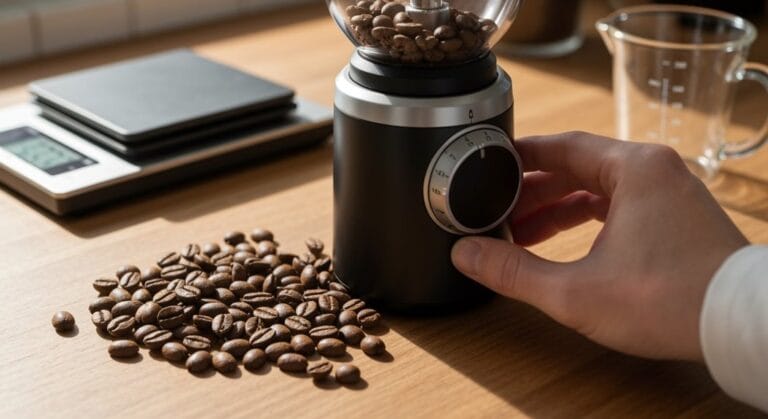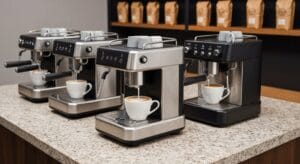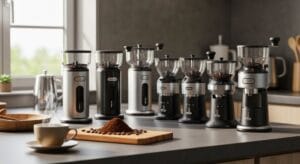Grinding coffee beans properly transforms your morning cup from meh to magnificent! Start by selecting quality beans and determining your brew method. Choose the right grinder (burr grinders give more consistency), then pulse in short bursts rather than continuous grinding to prevent overheating. Aim for the correct coarseness—fine for espresso, medium for drip, coarse for French press. Store your freshly ground treasure in an airtight container away from light and heat. The perfect grind awaits those who master these simple steps!
Key Takeaways
- Choose the right beans for your brewing method, with fresher beans requiring different grind settings than older ones.
- Select your grind size based on brewing method: coarse for French press, medium for drip coffee, and fine for espresso.
- Use a burr grinder for consistent results, or pulse a blade grinder in short bursts while shaking it.
- Grind only what you need in small batches to preserve flavor and prevent coffee from going stale.
- Store any leftover grounds in an airtight container at room temperature away from light, heat, and moisture.
Choosing the Right Coffee Beans for Grinding
Selecting the perfect coffee beans for grinding is like choosing a dance partner—the right match creates harmony while the wrong one leads to bitter disappointment. Bean origin plays a significant role here! High-altitude Arabica beans are naturally denser (which means finer grinding), while those Robustas from lower elevations need a coarser touch—who knew geography could be so important in your morning cup? The Arabica coffee originated in Ethiopia, making its origin even more significant in understanding flavor profiles. Different processing methods can also shape the flavor and impact your choice of grind.
The roast difference is another game-changer. Light roasts? Go finer to squeeze out those complex, acidic notes. Dark roasts? Keep it coarse, unless you enjoy that punch-you-in-the-face bitterness! Bean Adapt Technology from DeLonghi adjusts grind size based on both bean type and roast level, taking the guesswork out of the equation.
And remember, beans are living things (well, sort of)—they change as they age, so that grind setting that worked last week might need tweaking as your beans mature. Coffee’s just high-maintenance that way!
Understanding Different Grind Sizes and Their Uses
From the perspective of coffee grinding, size really does matter!
The grind texture you choose dramatically affects how your coffee tastes—too fine and you’ll get bitter sludge, too coarse and you’ll end up with coffee-flavored water (yuck!).
Grind size is the hidden hero of coffee brewing—it’s the difference between a flavor explosion and a disappointing cup.
Getting those brewing ratios right starts with matching your grind size to your brewing method.
- Extra coarse grinds (think peppercorns) work wonders for cold brew—patient coffee that takes its sweet time extracting.
- Medium grinds (sandy texture) are perfect for your everyday drip coffee makers.
- Fine grinds (almost powdery) make espresso machines sing with joy.
- Coarse grinds (sea salt-like) keep French press coffee from becoming a bitter nightmare.
To help elevate your brewing experience, consider using quality ingredients similar to those found in Third Wave Cafe’s offerings.
Essential Equipment for Home Coffee Grinding
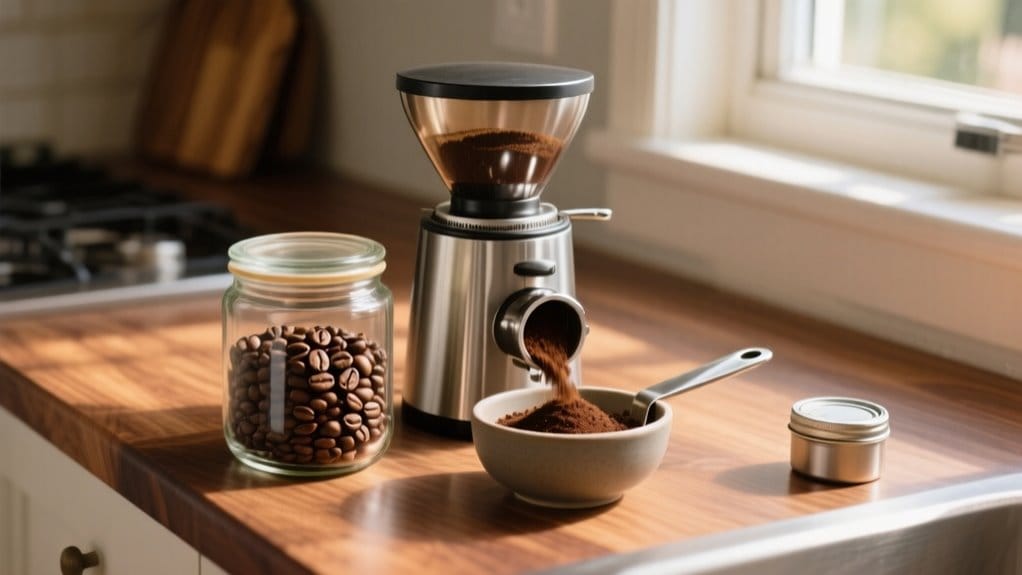
Now that you understand how grind size affects your brew, let’s talk about the gear that makes those perfect grinds possible! Home grinders come in two main flavors: manual grinders and electric grinders.
Manual grinders are perfect for coffee nomads! These hand-powered wonders use burrs to crush beans with impressive precision, and they’re super portable (camping coffee, anyone?).
Electric options make life easier—just push a button and voilà! They come as either burr or blade types. Burr grinders are the coffee snob’s choice, with conical burrs offering more consistency and less heat than their flat-burr cousins.
Blade grinders? They’re like the wild child of the coffee world—cheaper but, honestly, a bit chaotic with their uneven grinds. Shake ’em while grinding if you’re brave enough to try! Additionally, using different grind sizes can significantly influence the flavor characteristics of your coffee.
Step-by-Step Bean Grinding Technique
When you’ve got your beans ready and your grinder standing by, it’s time for the magic to happen—transforming those aromatic little nuggets into perfect grounds!
The key to successful grinding techniques lies in patience and control. Instead of one long, bean-murdering grind (hello, bitter coffee!), use short bursts that prevent overheating and preserve those precious oils.
Shake or tilt your grinder occasionally—it’s like giving your beans a little dance party that guarantees even grinding!
For grinding success, remember:
- Grind in small batches for better control (overfilled grinders are recipe disasters!)
- Use pulse grinding rather than continuous operation
- Check particle size frequently to avoid over-grinding
- Adjust gradually until you hit that sweet spot for your brewing method
Storing Your Freshly Ground Coffee Properly
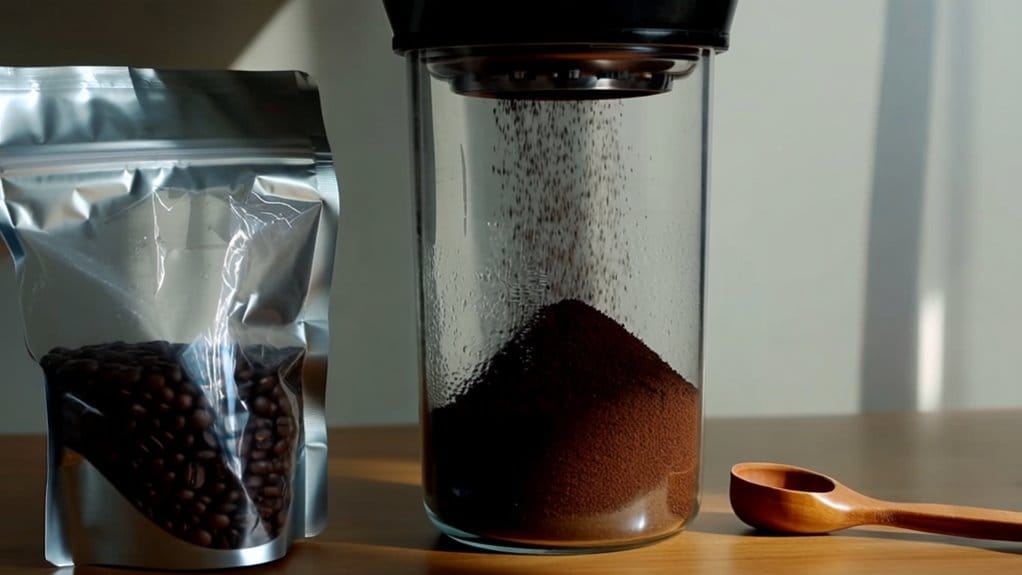
After spending all that time perfectly grinding your beans, the last thing you want is for your coffee grounds to go stale before you’ve even had a chance to enjoy them!
Coffee freshness depends entirely on how you store those precious grounds.
Protect your coffee’s soul by mastering the art of proper storage—it’s the difference between mediocre and magnificent.
Grab an airtight container made of ceramic, stainless steel, or opaque glass (not that flimsy plastic that absorbs everything!), and make sure it’s just the right size for your coffee amount—less air equals better flavor!
Then find a cool, dark spot away from your oven, sunlight, and that steamy dishwasher.
Your perfect storage conditions? Room temperature (68-72°F), low humidity, and absolutely no refrigerator unless it’s vacuum-sealed for freezing!
For the truly coffee-obsessed, portion your grounds into daily servings to minimize exposure.
Your future self will thank you!
Frequently Asked Questions
Can I Grind Coffee Beans in a Blender or Food Processor?
Like a chef without proper knives, one can use blender grinding or food processor grinding for coffee beans, but expect inconsistent results better suited for French press or cold brew methods.
How Long Does It Take to Grind Coffee Beans by Hand?
Manual grinding takes 30-90 moments depending on grind size, with espresso requiring 30-60 moments and coarser grinds taking 20-30 moments. Better grinders and refined grinding techniques reduce time considerably.
Can I Reuse Coffee Grounds for a Second Brewing?
Like squeezing a spent lemon, reusing coffee grounds for a subsequent brewing yields minimal results. While technically possible, most flavor extraction occurs during the initial brew, leaving a weaker, more bitter cup.
Are Pre-Ground Coffee Beans Significantly Worse Than Freshly Ground?
Pre-ground coffee is noticeably inferior to freshly ground beans. Prolonged exposure to air greatly impacts freshness, diminishing the flavor profile through oxidation of essential oils and aromatic compounds.
How Do Different Roast Levels Affect Grinding Difficulty?
Studies show light roasts can be up to 30% denser than dark roasts. Roast characteristics directly impact grinding difficulty, with denser light roasts requiring more force while brittle dark roasts produce more fines, affecting grind consistency.

